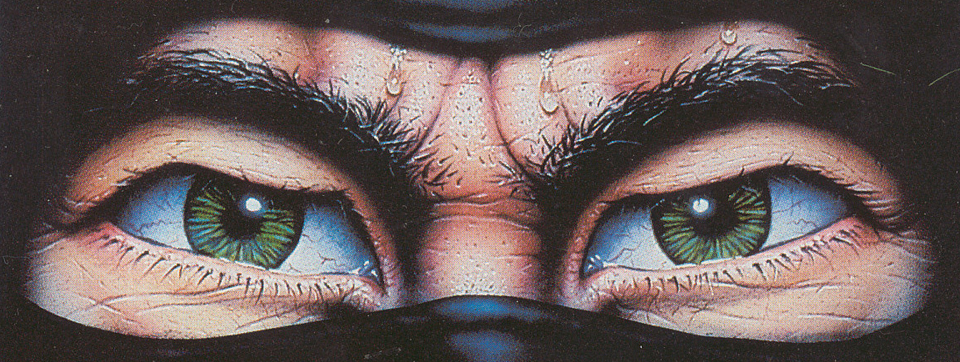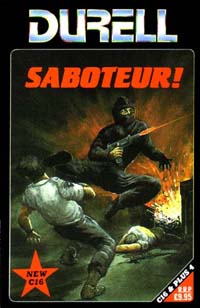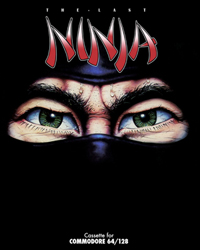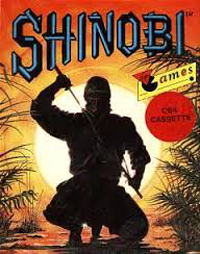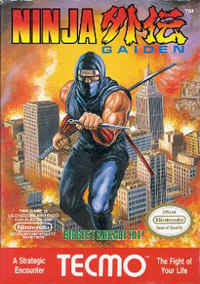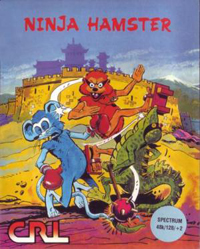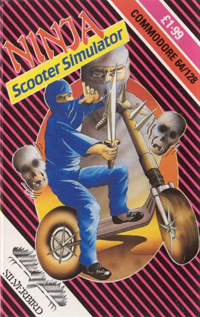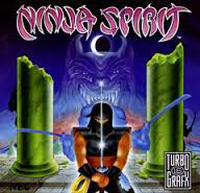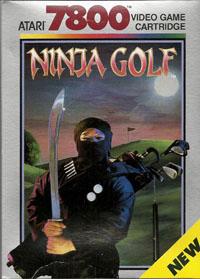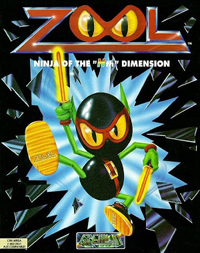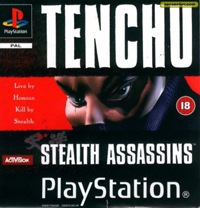Will The Last Ninja Out, Please Close The Door?
Ninjas are cool, and video games with ninjas are even cooler. Since the glory days of video and computer gaming in the 80s, there have been a whole raft of games that have featured to black clad assassins. So many games in fact that it was difficult to choose a list of the best or even the worst among all of them. Not having had the chance, or time, to play them all. So here is presented a personal list of the best and the worst that I have had the opportunity to experience over the years. From my very first ninja gaming experience, with Saboteur! on the Commodore 64, to the last ninja game I can recall playing, Tenchu: Stealth Assassins, on the PlayStation.
|
Saboteur! (1985): The first and still one of my favourite ninja themed games, I ever played. Saboteur! was an action-adventure game created by Clive Townsend and published by Durell Software, who later produced classics such as Thanatos and Turbo Esprit in 1986. As well as the hysterically titled Fat Worm Blows A Sparky. The game was released on the Commodore 64, ZX Spectrum, and Amstrad CPC.
In Saboteur! you played an anonymous ninja, tasked with sneaking into a warehouse to steal a floppy disk which has the names of rebel leaders on it. You had to make your way through a number of rooms (screens), to retrieve the disk and escape. Saboteur! was based on routines and ideas from Clive Townsend's unreleased 1985 game Death Pit. The game had innovative and overly extensive level select system, that spanned a massive 9 difficulty levels from "extremely easy" to "extremely hard". Not that there was much between them. As Saboteur! was a relatively easy game to play, even on the harder levels, and could be satisfactorily completed in a matter of minutes. As you retrieved the disk, and escaped in a helicopter to complete your mission. |
|
The Last Ninja (1987): When The Last Ninja was released it blew all other games out of the water, with its clever and innovative isometric view. It fast became one of the most successful games released on the Commodore 64, spawning two sequels. It's claimed that The Last Ninja sold a stunning 4 million copies world-wide.
The Last Ninja was an action-adventure game that was published by System 3 in 1987 for the Commodore 64, and later converted for the Apple II, BBC Micro, Acorn Electron, Amiga, Atari ST and the ZX Spectrum (as The Last Ninja Remix). The Last Ninja was combination exploration, puzzle solving and combat. The object of the game was to guide your ninja (Armakuni) through the palace of the evil shogun Kunitoki to assassinate him, avenging his clan, and retrieve the sacred scrolls. The Last Ninja is still one of those games that vintage gamers still hold dear, as a seminal moment of their gaming childhood. |
|
Shinobi (1988): Shinobi a side-scrolling action game produced by Sega originally released for the arcades in 1987. Later developed by Sega for their Master System gaming console, and later licensed to Nintendo for the NES, as well as home computer platforms like the Commodore 64, ZX Spectrum and Amstrad CPC.
In Shinobi, the player controls a modern day ninja named Joe Musashi who goes on a mission to rescue his kidnapped students from a group of terrorists called Zeed. Playing through five missions, you made your way through to Zeed's headquarters, freeing the hostages before confronting the end of level baddie in each mission. The success of Shinobi inspired the development of various sequels and spin-offs, making it one of the most well known and highly regarded ninja themed video games of the late 1980s and early 90s. |
|
Ninja Gaiden (1988): Ninja Gaiden like many other ninja inspired games, spawned a series of video games by Tecmo featuring the main character, ninja Ryu Hayabusa. The series was originally known as Ninja Ryukenden when released in Japan. The word "gaiden" in the version released outside of Japan means "side-story" in Japanese, even though the Ninja Gaiden series is not a spin-off or "side-story" of another game, confusingly. In Europe the game was originally released in arcades, and later on the NES and Game Boy, as Shadow Warriors.
Ninja Gaiden was renowned for its elaborate story-line and use of animated cut-scenes. It received extensive coverage and won several awards from video gaming magazines. However it was often criticised for its unrelenting levels of difficulty, as the game progressed through the levels. For those who did manage to battle their way through all the levels, which some magazine reviewers must have done, it won a number of awards for "Best Ending". I never finished it, so I wouldn't know! |
|
Ninja Hamster (1988): Ninja Hamster was rubbish, and an example of game developers attempting to cash-in on the late 80s fashion for all things ninja in gaming. It was a 2D fighting video game published by CRL for the Commodore 64, and later ported over to the ZX Spectrum. There was nothing new, innovative or clever about Ninja Hamster, which played out much like any other side-view fighting game of the time. Oh, maybe the energy bar made up of an "apple" that gets bites taken out of it each time the characters lose energy.
The player-controlled ninja hamster is on one side and the animals are on the other. The animals are all minions of the Sinister Rat. Combatants use joystick and button press combos to inflict damage on the opponent. Zzap!64 thought very poorly of Ninja Hamster. While easy to play, they felt the game had little staying potential. Battling characters took, in their view, too long and was repetitive. Yawn! Next?! |
|
Ninja Scooter Simulator (1988): Another game from the same year (1988 was a big year for the ninja), comes yet another ninja themed cash-in. The weird and wonderfully awful Ninja Scooter Simulator. Released for the Commodore 64 and ZX Spectrum.
Why a scooter simulator is anyone's guess. As in the 1980s, scooters were the most uncool mode of transport possible. They could have gone for a skateboard or a BMX, both very cool at the time. But no, the developers plumped for the the little kiddies mode of transport, the scooter. The premise of the game was simple. The ninja had to scoot along, using the joystick to speed up and slow down, avoiding obstacles along the way. Attempting to get to the end of the level before the timer runs out. Those amongst you who know your arcade history will have realised that Ninja Scooter Simulator looks a lot like a cheap copy of Namco's 1985 arcade game Metro-Cross, the two games being almost identical in gameplay. Then again, in Ninja Scooter Simulators defence, it was only £1.99. |
|
Ninja Spirit (1988): Moving on from crappy ninja theme cash-ins, back to a proper ninja game. Again from 1988, with Ninja Spirit. A side-scrolling beat-em-up. Originally released as an arcade game, and first released in Japan by Irem. Irem are better known for the development of the classic side-scrolling shoot-em-up arcade game R-Type. The game was later developed and ported over to home computer platforms, the Commodore 64, ZX Spectrum, Amstrad CPC, Amiga, Atari ST and apparently in Japan only the Game Boy.
In the game you played the ninja hero Gekkou, who lost his father to a mysterious half-man half-beast creature. The plot of Ninja Spirit is based on the quest of his revenge. |
|
Ninja Golf (1990): It didn't take long before we ended back up with a naff ninja cash-in. Ninja Golf was an Atari 7800 video game which combines side-scrolling beat-em-up with golf simulation gameplay. How do they come up with this stuff? Released in 1990, it later gained some unsurprising renown for its outlandish subject matter and (erm...) unique blend of gameplay styles.
The player starts each hole by aiming his ball and shooting it toward the green. He then runs toward the ball, in traditional side-scrolling style, fighting various enemies he encountered along the way to where his golf ball has landed. The enemies that your ninja golfer faced included other ninjas, gophers, birds, giant mutant frogs, sharks, dragons on the greens and more silliness besides.The enemies faced depended on the environment the ninja golfer is currently in. Sharks are encountered in water hazards and snakes in the sand traps. Enemy ninjas are encountered all over the golf course, attempting to kill our golfing ninja, unassumingly trying to enjoy a simple game of golf on his day off from ninjering. |
|
Zool (1992): Or to give it its full title, Zool: Ninja of the Nth Dimension, was a cutesy platform game originally produced for the Amiga by Gremlin Graphics in 1992. It was later ported to several other platforms and followed by the sequel Zool 2 in 1993. The game was a straight up platform game, that was so popular in the mid-1990s. It was developed as a rival to the massively popular Sega game Sonic the Hedgehog. And despite in no way being able to compete with the massive success of Sonic, Zool did gain relative success and a minor cult following.
Zool featured the eponymous hero who was forced to land on Earth, in order to gain ninja ranking. As the player, you guided Zool through seven lands. The game contains a number of embedded mini-games, including several style arcade games, a scrolling space shooter and a game accessible only by making Zool play a certain tune on an in-game piano or finding certain invisible warp points. |
|
Tenchu: Stealth Assassins (1998): And finally, the last but by no means the least ninja game on the list. Tenchu: Stealth Assassins was an action-adventure stealth game developed by Acquire and published by Sony for their first PlayStation platform, in Japan and by Activision world-wide. Tenchu is known for its innovative use of "stealth" gameplay, the first to do so, which is now common in many games. It was also noted for its atmospheric graphics and the eerie settings of feudal Japan.
Tenchu had a full story-line and cut-sequences, which incorporated elements of historical Japanese fantasy and mythology. The game takes place in feudal Japan, introducing a pair of player characters, ninja Rikimaru and Ayame. You could choose to play as either, for two gameplay variations. |

You Must Defeat Sheng Long To Stand A Chance - One of the greatest hoaxes and most persistent mysteries in gaming history. The character of Sheng Long in the Street Fighter series.
|
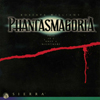
Phantasmagoria: Vintage Gore In FMV! - The controversial survival horror adventure game, and one of the first games to use Full Motion Video. Or just a bad b-movie you had to play!
|

